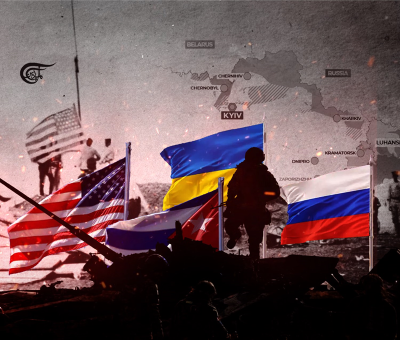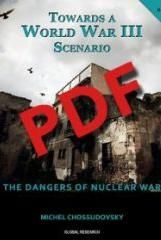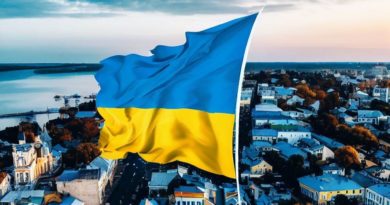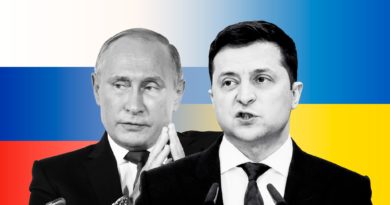The Endless Proxy War, by Design. “Direct Conflict and Then Go Nuclear”

All Global Research articles can be read in 51 languages by activating the Translate Website button below the author’s name.
To receive Global Research’s Daily Newsletter (selected articles), click here.
Follow us on Instagram and Twitter and subscribe to our Telegram Channel. Feel free to repost and share widely Global Research articles.
***
Russia’s invasion of Ukraine has presented the White House with a geopolitical crisis that it played a critical role in creating. In February 2014, Victoria Nuland, a current senior State Department official and former Dick Cheney advisor, was caught on tape plotting the installation of a new Ukrainian government – a plan, she stressed, that would involve Biden and his then-top aide, and current National Security Advisor, Jake Sullivan. Weeks later, the democratically elected Ukrainian president Viktor Yanukovych was ousted and replaced by Washington-backed leaders – including a prime minister selected by Nuland.
The regime change in Kiev made Biden the most influential US political figure in Ukraine, as underscored by the lucrative Burisma board seat gifted to his son Hunter. While the Biden family and other well-connected players profited, Ukraine fell into civil war.
In the eastern Donbas region, Kremlin-backed Ukrainian rebels took up arms against a fascist-infused coup government that cracked down on Russian culture and countenanced murderous assaults on dissidents. Rather than promote the 2015 Minsk II accords — the agreed-upon formula for ending the Donbas conflict – the US fueled the fight with a weapons and training program that turned Ukraine into a NATO proxy. Influential US politicians left no doubt about their intentions. As the Donbas war raged, lawmakers declared that they were using Ukraine to “fight Russia over there” (Adam Schiff) and vowed to “make Russia pay a heavier price,” (John McCain). In February of this year, Russia invaded to bring the eight-year fight to an end, leaving Ukraine to pay the heaviest price of all.
The Biden administration shunned multiple opportunities to prevent the Russian assault. When Russia submitted draft peace treaties in December 2021, the White House refused to even discuss the Kremlin’s core demands: a pledge of neutrality for Ukraine, and the rollback of NATO military forces in post-1997 member states that neighbor Russia. At the final round of talks on implementing Minsk II in early February, the “key obstacle,” the Washington Post reported, “was Kyiv’s opposition to negotiating with the pro-Russian separatists.” Siding with Ukraine’s far-right, which had threatened to overthrow Volodymyr Zelensky if he signed a peace deal, the US made no effort to encourage diplomacy. Emboldened to escalate its war on the Donbas, the Ukrainian government then massively increased shelling on rebel-held areas in the days immediately preceding Russa’s February 24th invasion.
Looking back at the pre-invasion period, Jack Matlock, the US ambassador to the Soviet Union under Bush I, now concludes that “if Ukraine had been willing to abide by the Minsk agreement, recognize the Donbas as an autonomous entity within Ukraine, avoid NATO military advisors, and pledge not to enter NATO,” then Russia’s war “probably would have been prevented.”
For Washington, preventing the war would have interfered with longstanding objectives. As US policymakers have openly recognized, Ukraine’s historical, geographical, and cultural links to Russia could be used as a tool to achieve regime change in Moscow, or, at minimum, leave it “weakened.”
As Ukraine enters another winter of war, this time facing an intensified Russian assault, the Biden administration is apparently in no mood to end a crisis that it helped start.
In an interview with CNN, President Biden declared that he has “no intention” of meeting with Vladimir Putin at the upcoming G20 summit. “I’m not about to, nor is anyone else prepared to negotiate with Russia,” Biden said.
A recent account in the Washington Post details the White House’s prevailing mindset:
Privately, U.S. officials say neither Russia nor Ukraine is capable of winning the war outright, but they have ruled out the idea of pushing or even nudging Ukraine to the negotiating table. They say they do not know what the end of the war looks like, or how it might end or when, insisting that is up to Kyiv.
“That’s a decision for the Ukrainians to make,” a senior State Department official said. “Our job now is to help them be in absolutely the best position militarily on the battlefield … for that day when they do choose to go to the diplomatic table.”
If the US knows that its ally Ukraine is not “capable of winning the war”, why would it choose to prolong it? The stated aim to put Kiev “in absolutely the best position militarily on the battlefield,” has been offered for months. Yet during this time Russia has held on to about 20% of Ukrainian territory and positioned itself for a major escalation. The Russian army is preparing to deploy some 300,000 reservists, and has recently conducted its most ferocious missile barrages to date, causing serious damage to Ukraine’s civilian infrastructure, as US officials had predicted.
While Ukraine has scored some battlefield successes, there is no indication that its strategic position has significantly improved. The counter-offensive in Kharkiv reportedly came at the cost of high Ukrainian casualties, a type of victory that is unsustainable. The Russian pullback, a Western official told Reuters, was more likely a “withdrawal, ordered and sanctioned by the general staff, rather than an outright collapse… the Russians have made some good decisions in terms of shortening their lines and making them more defensible, and sacrificing territory in order to do so.” The most audacious of Ukraine’s counter-attacks – the bombing of the Kerch bridge – “did not appear to have done permanent damage to the bridge — or to Russia’s war effort,” the New York Times reported. Instead, it only triggered a far more destructive Russian retaliation.
The stated White House position of treating diplomacy as “a decision for the Ukrainians to make” is also based on a false premise. For one, when Ukraine previously did “choose to go to the diplomatic table,” with Russia and even made significant progress, its Western backers in London and Washington sabotaged it, according to multiple accounts.
And whether Ukraine wants to negotiate, the US is not obligated to supply the weaponry and intelligence that sustains the fight. The US role as a co-belligerent in the US conflict is a political choice, not a law of nature. And given that US officials privately admit that Ukraine is not “capable of winning the war,” that would seemingly obligate them all the more to use their considerable leverage to bring this un-winnable war to a speedy end.
Yet another imperative for resolving the conflict is the nuclear threat that it continues to fuel. According to Leon Panetta, the former CIA director and defense secretary, “intelligence analysts now believe that the probability of the use of tactical nuclear weapons in Ukraine has risen from 1-5 percent at the start of the war to 20-25 percent today.” In this “proxy war between Washington and Moscow,” former State Department official Jeremy Shapiro warns, both sides “are locked in an escalatory cycle that, along current trends, will eventually bring them into direct conflict and then go nuclear, killing millions of people and destroying much of the world.” Even if these warnings are overblown, the very fact that they are even being articulated by well-placed former US officials should obligate all parties to demonstrate an effort for peace.
In both the US and Russia, the only apparent response to the threat of terminal conflict is to fuel it. This week, NATO has kicked off its annual nuclear exercises, featuring a fleet of aircraft including U.S. long-range B-52 bombers. Russia is slated to hold its own maneuvers as well.
Meanwhile, rather than negotiating, the US and its partners are devoted to global arms dealing. To procure the Russian-style weapons that Ukrainian soldiers are trained to use, “the United States and other allies have been scouring the globe,” the New York Times reports. Relieved of any need to attempt diplomacy, Secretary of State Antony Blinken has visited Asia, Africa, and Latin America “in a painstaking, behind-the-scenes diplomatic campaign to countries that have demonstrated support for Ukraine but are still reluctant to supply lethal aid.” Over the long-term, a senior NATO official told Politico, the Western goal is “to get Ukraine fully interoperable with NATO.”
Lost in this “painstaking” scramble to find weapons for the Ukraine proxy war is the question of whether there will be any of Ukraine left behind. “[T]he longer the war continues,” Matlock, the former US ambassador to the USSR, writes, “the harder it is going to be to avoid the utter destruction of Ukraine.” A prolonged war also threatens a “winter of de-industrialization” in Europe, along with increased hunger and impoverishment around the globe.
Despite his experience as a US diplomat who helped negotiate an end to the Cold War, Matlock’s opposition to the current cold war has left him banished from establishment US media outlets. In this militaristic climate, it is only on rare occasions that voices of restraint can break the sound barrier.
Speaking recently to ABC News, retired Admiral Mike Mullen, the nation’s top military officer under both Bush II and Obama, urged the White House to find an off-ramp. Of Biden’s warning of a nuclear “Armageddon,” Mullen said: “I think we need to back off that a little bit and do everything we possibly can to try to get to the table to resolve this thing… The sooner the better as far as I’m concerned.”
The Biden administration has taken the inverse position: for their proxy war against Russia, the longer the better, no matter how many more lives in Ukraine are sacrificed by policies designed in Washington.
*
Note to readers: Please click the share buttons above. Follow us on Instagram and Twitter and subscribe to our Telegram Channel. Feel free to repost and share widely Global Research articles.
Featured image is from Al Mayadeen English
 “Towards a World War III Scenario: The Dangers of Nuclear War”
“Towards a World War III Scenario: The Dangers of Nuclear War”
by Michel Chossudovsky
Available to order from Global Research!
ISBN Number: 978-0-9737147-5-3
Year: 2012
Pages: 102
PDF Edition: $6.50 (sent directly to your email account!)
Michel Chossudovsky is Professor of Economics at the University of Ottawa and Director of the Centre for Research on Globalization (CRG), which hosts the critically acclaimed website www.globalresearch.ca . He is a contributor to the Encyclopedia Britannica. His writings have been translated into more than 20 languages.
Reviews
“This book is a ‘must’ resource – a richly documented and systematic diagnosis of the supremely pathological geo-strategic planning of US wars since ‘9-11’ against non-nuclear countries to seize their oil fields and resources under cover of ‘freedom and democracy’.”
–John McMurtry, Professor of Philosophy, Guelph University
“In a world where engineered, pre-emptive, or more fashionably “humanitarian” wars of aggression have become the norm, this challenging book may be our final wake-up call.”
-Denis Halliday, Former Assistant Secretary General of the United Nations
Michel Chossudovsky exposes the insanity of our privatized war machine. Iran is being targeted with nuclear weapons as part of a war agenda built on distortions and lies for the purpose of private profit. The real aims are oil, financial hegemony and global control. The price could be nuclear holocaust. When weapons become the hottest export of the world’s only superpower, and diplomats work as salesmen for the defense industry, the whole world is recklessly endangered. If we must have a military, it belongs entirely in the public sector. No one should profit from mass death and destruction.
–Ellen Brown, author of ‘Web of Debt’ and president of the Public Banking Institute
This article has been archived for your research. The original version from Global Research can be found here.


